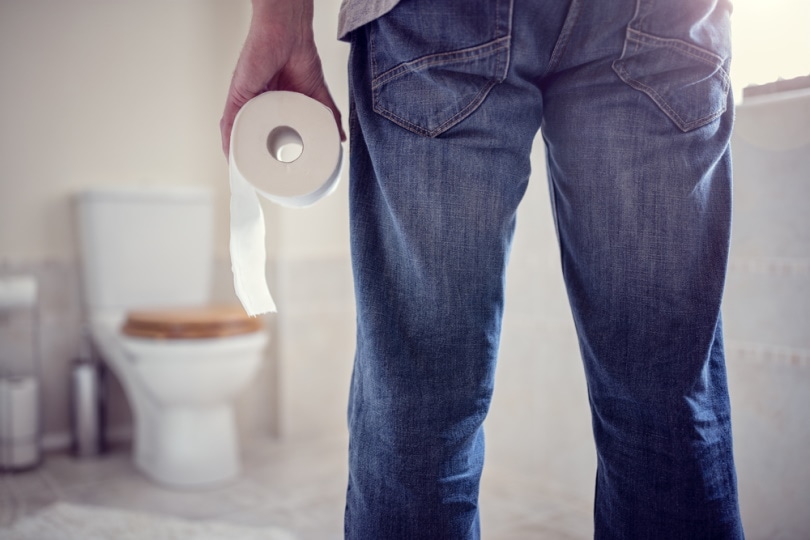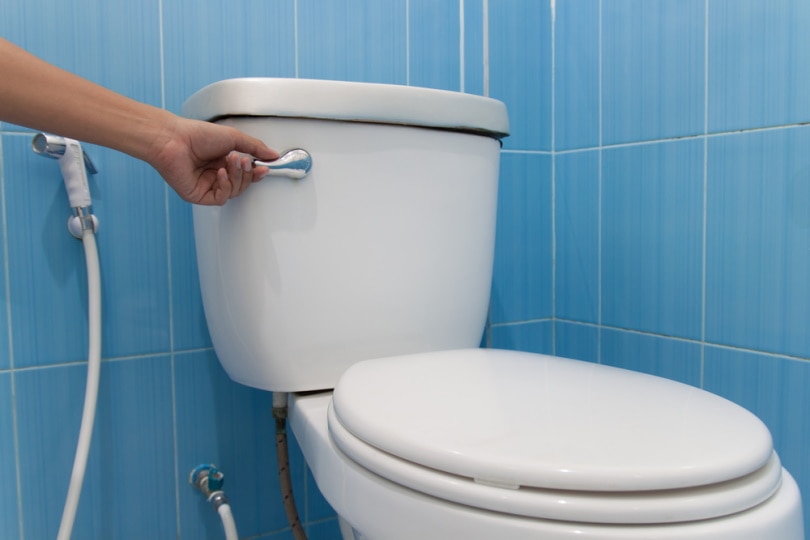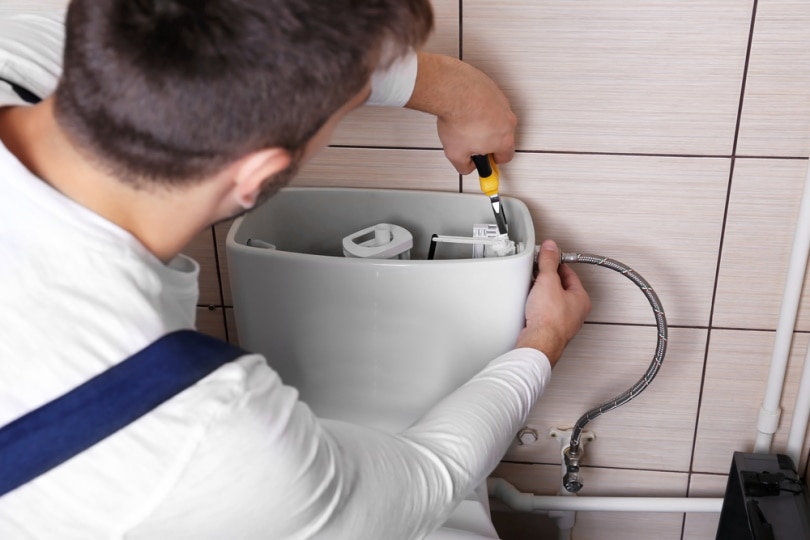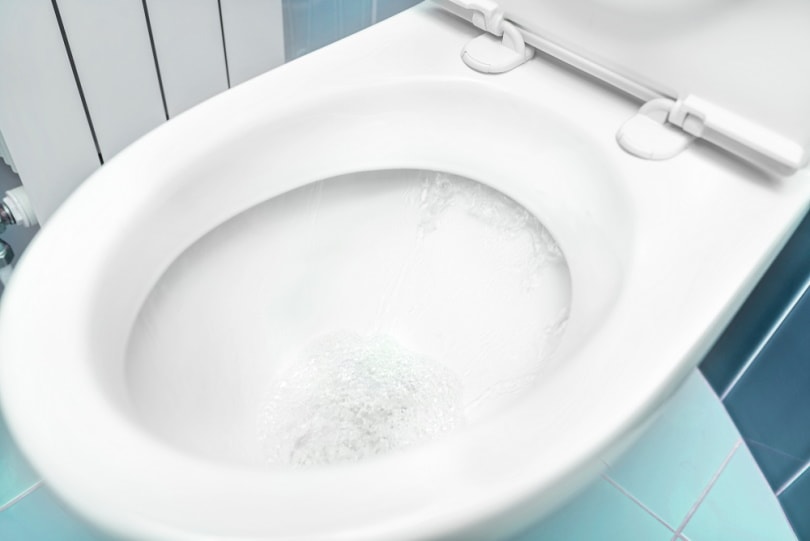Why Is My Toilet Flushing Slow? 9 Possible Reasons
-
Pete Ortiz
- Last updated:

Nothing is quite as frustrating as having to deal with a slow-flushing toilet. If you urgently need to use the facilities right after someone has left, you may have to hold it for a few more minutes until the toilet completely flushes. You may also be forced to flush twice or more times to completely rid of the leftover waste which is particularly embarrassing if you have guests in your home.
There are many reasons why your toilet flushes slowly and ineffectively. They include clogging issues on the toilet pipes, toilet component failures, and an insufficient level of water in the toilet tank. These issues not only cause mild inconveniences to the owner, but they can be dangerous too. For instance, leftover wastes can start to stink, attracting pests and diseases and if the clogging gets too bad, it can lead to overflows.
Determining the root cause of slow flushing in toilets is necessary before attempting to fix the problem. Fortunately, once you can pinpoint the exact cause, fixing slow flushing toilets is easy without even the assistance of a certified professional plumber.
In this article, we take a look at an in-depth breakdown of the reasons for these flushing issues and the possible solutions. Read on to learn more.
The 9 Possible Reasons for a Slow-Flushing toilet
As earlier mentioned, there could be several reasons your toilet flushes slowly and incompletely. We have broken down these reasons into clogging issues, component failures, and water issues to help you understand them better.
Clogging Issues
Blockages and clogs in the toilet are the most common reasons why a toilet is flushing slowly. Fortunately, all the clogging issues identified below are easy to detect and fix.
1. Excessive Toilet Paper and Debris Build-Up

Using more toilet paper than the toilet can handle is perhaps the leading cause of blockages in toilets. However, clogging doesn’t just happen once when you dump a lot of toilet paper. It is usually a problem that has built up over time, and this problem is common in older homes.
Sure, toilet paper is designed to dissolve in water but can also leave a sticky residue. This is common in tissue papers that are thicker than 2-ply. While a thick roll may feel comfortable, it can be quite difficult to flush down a toilet. This is particularly common in sewer lines experiencing issues such as misalignments and corroded interiors. They tend to attract debris that is flowing by, thus clogging the toilet.
Solution
Similar to fixing a clogged S trap, a plunger will come in handy in removing excess toilet paper and debris from your toilet. Simply place a plunger over your toilet drain, then pump it while keeping it sealed to the drain opening. Repeat this process until you get rid of all debris clogging up the pipes. If the plunger doesn’t work, consider calling your local plumber to assist with unclogging your toilet pipes.
2. Clogged S-Trap
The S-trap is an S-shaped pipe located below the toilet bowl. All toilets have an S-trap fixture for two main reasons. It holds a fixed amount of water in the toilet bowl which functions as a barrier, thus preventing sewer gasses from bubbling back into the bathroom after flushing. It also holds different types of debris, preventing them from clogging up the lower levels of the drain pipe where it would be harder to unclog.
The S-trap also helps generate the siphoning effect, which assists with the flushing process. One end of the S is usually shorter than the other, so that once you flush the toilet, water from the bowl fills the toilet trap’s shorter end. This prompts wastewater to flow and fill the longer end as well. This will create a suction effect pulling water in the short end of the toilet bowl until all wastewater has been siphoned out.
Due to this S shape curve, debris, and wastes such as too much toilet paper can easily get stuck, prohibiting water movement down the drain. You will notice that the siphoning effect is not as strong as required. This creates slow flushing, and you may need to flush at least twice to get rid of the wastewater.
Solution
The best way to clean a clogged S trap is by using a typical plunger. If the water in the bowl hasn’t fully drained out, you should first remove about 2 inches of it from the toilet bowl. Start by placing the plunger over the drain located at the bottom of the drain, then quickly pump up and down. The pumping motion should unclog the drain. However, do not blow out your pipes by pumping too hard. As you pump, ensure that the plunger is firmly secured and you don’t overdo it.
3. Clogged Drain Pipe

Toilet sinks and bathrooms have separate drain pipes. These separate drain pipes will be connected further down the line and they will drain their products on the main house drain pipe, which finally empties into the sewer system or a septic tank.
When the toilet drain pipe is partially clogged, you will experience a slow flushing toilet. This is evident when you flush because the bowl fills up and takes longer to drain out. Clogged drain pipes are usually caused by tree roots growing in the sewer line. If these roots are not removed while still young, you may end up replacing the sewer pipes, which is a very costly affair.
Solution
If your toilet is slowly flushing because of a partially blocked drain pipe, the simplest solution is plunging the toilet. A plunger creates enough force to clear any blockage or clogs from your drainpipe. However, if this doesn’t work, try using a drain to restore the flushing power. If debris like toys, wipes, and floss are lodged into the drain line, it is difficult to dislodge them to allow the water to flush through. You might have to hire a plumber to remove the blockage in your drain pipe.
4. Clogged Vent Stack
A vent stack is typically the vertical pipe that runs from a house’s drain pipe to the roof. This is an important fixture because it provides an outlet for sewer gasses to flow out of the drain pipe. Moreover, it also allows the circulation of fresh air inside the drainpipe.
When the vent stack gets clogged, the pressure inside the drain pipe will build up, resulting in a slow-draining toilet. This problem is not just present in your toilet but in all other fixtures in your home. The other signs of a clogged vent stack you should look out for include:
- Foul sewer odor in the house
- Toilet bubbles when a toilet is flushed or the shower is drained
- Shower or bathtub drain gurgle when a toilet is drained
Solution
Clearing a vent stack is often difficult because you have to climb up to the roof to access and inspect the vents. This is especially problematic if you don’t know what issue you are looking for. Therefore, consider hiring a professional plumber to inspect and clear the clogged vent stack.
Toilet Equipment Failure
5. Faulty Toilet Fill Valve

When a fill valve is worn out or faulty, it will not be able to refill the tank after flushing a toilet. The fill valve located at the bottom of the tank regulates water flow from the tank to the toilet bowl. So, flushing the toilet essentially allows the fill valve to open, allowing water to pass into the toilet bowl.
Therefore, when the toilet keeps running after the toilet has flushed, the fill valve, also known as the flapper, is likely faulty. Faulty flappers are not only irritating, but the high amount of water required to keep your toilet functional will also increase, thus increasing water bills.
When you let go of the toilet handle, you will lift the fill valve allowing you to uncover the passage. This will likely result in a slow-functioning toilet. In addition, the chain lift can get stuck, prohibiting the fill valve from fully opening up. This will also limit the amount and speed of the water draining out of the toilet into the toilet bowl.
Solution
To resolve the problem of a faulty toilet valve, first, inspect the toilet assembly. Most often, the issues arise from a chain stuck or trapped in position. You may have to open the flapper mechanism to readjust the chain if need be. Otherwise, contact a professional plumber to help you replace this component of the toilet.
6. Blocked Jet Holes
Another common reason why toilets flush slowly is the presence of buildup that clogs the jet holes. When you flush a toilet, water is released through rapid water jets filling the toilet bowl. The streams of water get into the bowl through jet holes, usually located below the toilet bowl rim.
If these holes, sometimes referred to as inlet or rim holes, are not routinely and thoroughly cleaned, they can easily get blocked or partially clogged. Their small size doesn’t let debris pass through. Debris found on the sides of the toilet bowl and tank often originate from hard water minerals such as calcium, magnesium, or even bacteria.
Over time, the mineral deposits will also create a barrier that slows water movement down the drain. Eventually, the mineral deposits will slow down the force of the flush. Your toilet will end up flushing at a slower speed than you had expected.
Solution
To fix clogged toilet jets, first, inspect the holes using a mirror. If there is bacterial growth, you will notice black spots, whose color may vary to indicate a dark orange color. Mineral deposits on the pipes are usually lighter and scaly. If bacteria growth limits your flush speed, you will need a bleach solution made up of bleach and water.
Pour the solution inside your overflow tube, wait for about 10 minutes, then flush the toilet. You can then proceed to clean the holes using a mirror and a piece of wire, thin enough to access the small crevices of the jet holes. Finally, clean the rim underside of your toilet with a toilet cleaner. You can repeat this process until you unblock all the toilet jet holes.
If dealing with mineral deposits, you may have to heat 12 ounces of vinegar to 120 degrees. Then pour the mixture into the overflow tube and wait for at least an hour. You can then proceed to use the same procedures used in removing bacterial growth.
7. Older Toilet Models

Most old toilet models usually experience clogs and blockages, which affect the flushing speed. These older models are rarely equipped with a tank that is big enough to accommodate the water required for flushing. Therefore, even if the fill valve occasionally replenishes the tank with water, it will not have enough force to flush waste water down the drain.
Solution
So, if your toilet is an older model, you might want to upgrade it with a newer model to achieve the needed flush speed. Fortunately, new models come with new and efficient designs that will give you plenty of flushing power without increasing your water bill expenditure. Modern toilets generally cost between $100 to $500 and measure up to 14” tall. They also retail in a variety of shapes.
Water Issues
8. Low Water levels
As earlier mentioned, the toilet tank has to have the recommended amount of water to flush waste products and push them down the drain. Hence, if the water level in the toilet tank is lower than the recommended amount, the toilet may flush slower than expected.
When you have the correct amount of water, the toilet jets will flush with a force that is strong enough to initiate the siphon action required to flush a toilet.
Solution
Diagnosing water level issues in a toilet is fairly easy. If your toilet is flushing slower than expected, simply remove the toilet tank lid, and inspect. The water level should always be slightly more than a half inch below the top of the overflow tube. If lower, the water level will not be able to generate enough force to flush down toilet wastes down the drain.
To fix this water level issue, change the leveling of the float usually located in the toilet’s tank. A toilet float is usually on the top of the water and turns automatically to close the fill valve when water reaches optimum levels in the tank. So, you can adjust the toilet float to allow more water into the tank before the fill valve detects and shuts down to increase the flushing power.
9. Hard Water

Hard water is made from dissolved minerals like magnesium and calcium. You can easily identify hard water by checking if soap scum remains on your toilet components. If you notice hard water residue in your toilet, the minerals have accumulated inside the toilet pipes. This reduces the size of the drainage pipes, making the water flush slower from the toilet bowl.
Solution
To reduce the mineral buildup from hard water in your toilet drainage system, use a stiff toilet brush and white vinegar. These products have enough power to disintegrate the minerals build-up, thus restoring the toilet’s flushing power. Simply pour one quart of white vinegar into your overflow tube and then wait overnight.
Depending on how much build-up you have, it may take you a while to loosen and dissolve the calcified minerals. Alternatively, use a water softener on your toilet tank water to ensure that the problem doesn’t persist in the future.
Conclusion
Understanding the functionality of your toilet, the reasons why it experiences slow flushing, and the solutions to such a scenario is very necessary so that you can know how to increase pressure in your toilet pipes to completely flush your toilet wastes in a fast and expedient manner.
Toilets are usually slow flushing due to clogging caused by the use of excess toilet paper and other debris that is too thick and heavy for the toilet to handle. Sometimes toilet equipment such as the drain valve may be faulty, limiting the amount of water required to achieve successful flushing. However, the toilet could not have accumulated enough water in the drain pipe to flush wastewater from your toilet.
No matter the case, always ensure that your toilet is functioning and can get rid of waste from the toilet properly. If the solutions mentioned above don’t work, hire a professional plumber to help restore the flushing power of your toilet.
See also:
Featured Image Credit: Am.p, Shutterstock
Contents


